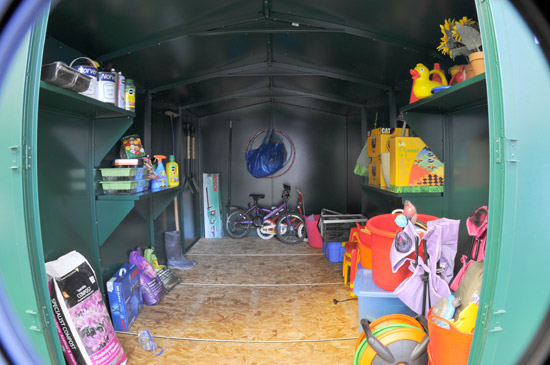Storing your paint in a dry Asgard shed
How to store left over paint
No matter the size of your painting project, odds are youwill have at least one partial container of paint left over when the job is done.
If the paint was a special mix, then you'll probably want to keep that remaining paint in good condition. It could come in handy if you ever have to touch-up or re-paint a scratched or damaged wall in the future.
The problem is no one wants to keep lots of cans of paint in their house. So, without thinking twice, leftover paint cans usually end up on a shelf in the garage or stacked in a corner of the shed in the backyard.
Unfortunately, extreme temperature changes can wreak havoc on your leftover paint!
Here are the best ways to store paint so you can actually reuse what's left over at some point:
Extreme Temperatures
When left over paint is stored in a place that gets very hot or very cold, the paint will change in consistency,making it unusable.
Eventually, the paint will turn into hazardous waste and it must be disposed of in an ecologically friendly manner, rather than being tossed in with your regular trash.
Latex paint, in particular, tends toseparate in extreme temperatures. One freeze/thaw cycle will turn it into acurdled mess that will no longer blend into usable paint. Excessive heat will dry out the paint, leaving a thick skin across the top of the paint. If left long enough, the remaining paint will turn into a solid rubbery block.
Where To Store Paint
The key to successful paint storageis to keep it in a cool dry place.
For example, a nice dry basement isa good place to store paint.
Don't have a basement? Find a spotin a closet inside your house. The 2 most important factors when you're choosing a place to store leftover paint are: low-moisture and temperature-controlled.
You want to avoid places with high moisture because metal paint cans will quickly form rust around the lid. As soon as you open a paint can with a rusted lid, pieces of rust and debris willfall into the paint and ruin your paint job. (I prefer the newer plastic paint cans since rust isn't an issue with them.)
If the basement is where you'll be storing leftover paint, be sure to keep the paint cans off the concrete floor because moisture will wick up and create rust.

How To Store Paint
By keeping air from getting at the paint, you will prolong the life of your leftover paint.
Here's how to store paint with the least amount of air possible:
Take the time to clean paint out of the sealing rim of the can, in order to obtain a tight seal.(Don't wipe your paint brush on the lip/rim of the can while painting, because paint will get in the grove making it difficult to seal the lid properly.)
Use a layer of plastic wrap as a gasket between the can and lid.
Store paint cans upside down, so the paint itself creates an air tight seal against the lid.
Avoid beating on the lid with a hammer when you close the can. Such force will only deform the sealing rim and allow air to come in. Instead, use a rubber mallet with a light touch, just enough to ensure that noair can get in.























